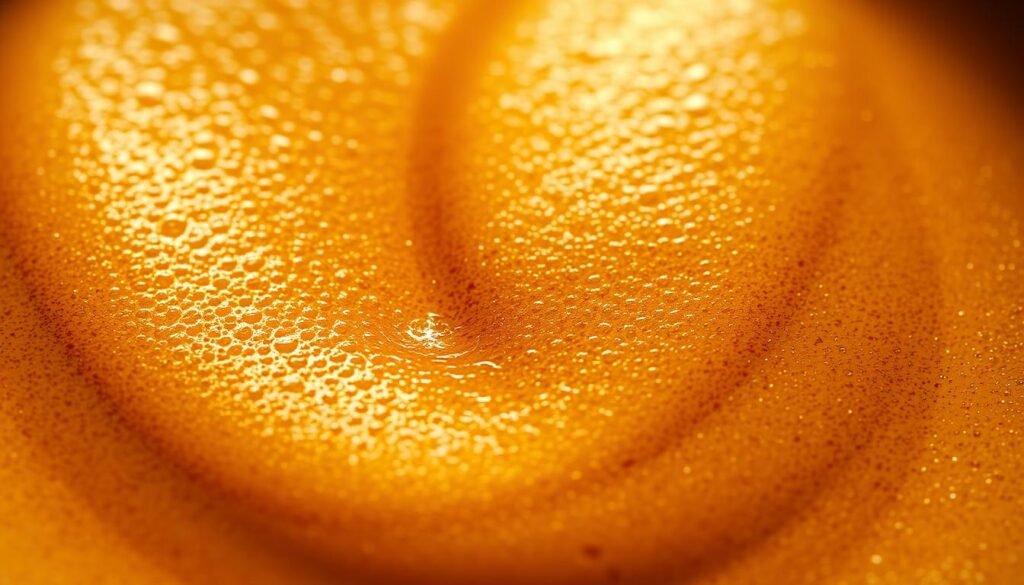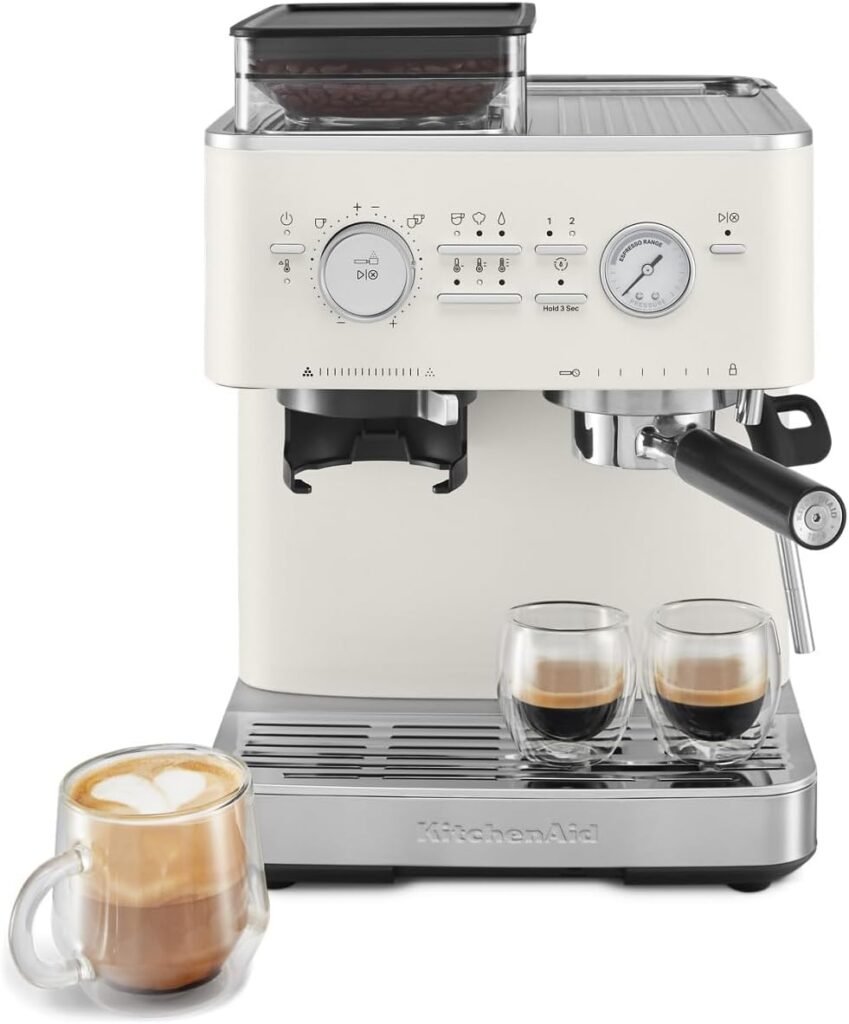As a coffee enthusiast, I’ve always been fascinated by the crema that crowns a perfectly pulled shot of espresso. This creamy, reddish-golden foam is not just visually appealing; it’s a hallmark of a well-crafted coffee experience.
When hot water is forced through coffee grounds at high pressure, it creates an emulsion of coffee oils and gases, forming the crema on top. This layer is a critical indicator of espresso quality, contributing significantly to the overall experience.
Understanding crema is essential for anyone looking to elevate their espresso coffee game. Throughout this guide, we’ll explore the science behind crema, its characteristics, and factors affecting it, as well as how to achieve the perfect crema at home.
Key Takeaways
- The importance of crema in the espresso experience
- How crema forms on a properly extracted espresso shot
- Factors that affect the quality of crema
- Tips for achieving perfect crema at home
- The role of crema in indicating espresso quality
The Golden Crown: What Is Espresso Crema?
Crema, the golden layer on your espresso, is more than just a visual treat. It’s a crucial component of a well-made espresso shot, contributing to both the flavor and the overall experience.
The Science Behind the Foam
The formation of crema is rooted in the science of emulsification and the behavior of carbon dioxide under pressure. When coffee is roasted, it releases CO2, which gets trapped in the beans. During the brewing process, especially under high pressure, this CO2 is dissolved into the water. As the espresso flows into the cup, the sudden drop in pressure causes the CO2 to form tiny bubbles, creating the frothy crema. This process involves the emulsification of coffee oils, proteins, and sugars, resulting in the characteristic creamy texture.

A Brief History of Crema
The appreciation of crema as we know it today began with Achille Gaggia’s invention of the ‘Lampo’ espresso machine in 1948. Gaggia’s innovation allowed for high-pressure extraction, making it possible to produce espresso with a rich, creamy crema. Initially called “caffe creme” in Italy due to its creamy appearance, crema quickly became a benchmark for quality espresso. Over time, the appreciation for crema has evolved from being a novelty to a standard expectation in espresso culture.
| Aspect | Description |
|---|---|
| Composition | Tiny bubbles of carbon dioxide gas, coffee oils, proteins, and sugars |
| Formation Process | High-pressure brewing, sudden release of pressure, emulsification |
| Historical Significance | Achille Gaggia’s 1948 invention revolutionized espresso with crema-topped shots |
Why Crema Matters in Your Espresso Experience
The crema on your espresso is more than just a visually appealing topping; it’s a crucial element that enhances your overall coffee experience. Crema contributes significantly to the flavor and aroma of your espresso, making it a vital component of a well-crafted cup.
The Flavor Impact of Crema
Crema plays a pivotal role in balancing the flavor profile of your espresso. While it may taste bitter on its own, when integrated with the espresso, it helps to mitigate bitterness and enhance the overall flavor. The creamy texture of crema also adds to the mouthfeel, providing a fuller and more satisfying experience. By preserving the volatile aromatic compounds, crema ensures that the espresso’s aroma is retained, further enriching the sensory experience.

Visual Indicators of Quality
The appearance of crema serves as a visual indicator of the quality of your espresso. A thick, creamy crema is often considered a sign of excellence, indicating proper extraction parameters and fresh coffee beans. The color of the crema, ranging from light golden brown to dark reddish-brown, can also provide insights into the brewing technique and the quality of the espresso. A well-formed crema is not just aesthetically pleasing; it’s a sign of a well-crafted espresso that promises a rich and satisfying flavor experience.
Characteristics of the Perfect Espresso Crema
The perfect espresso crema is a hallmark of a well-crafted shot, and its characteristics are worth exploring. A well-made crema is not just visually appealing; it’s also a sign of a high-quality espresso.
Color, Texture, and Persistence
The ideal crema has a tawny, hazelnut-brown color with reddish-golden highlights, creating a beautiful contrast with the dark espresso beneath. The texture should be smooth and velvety, with fine, uniform bubbles rather than large, irregular ones. In terms of persistence, quality crema should maintain its integrity for approximately two minutes before gradually dissolving back into the espresso.
Testing Your Crema Quality
To evaluate your crema quality, try the “tilt test”: Tilt your cup and observe if the crema stretches to cover the surface of your espresso. If it re-forms when you set the cup back upright, you’re holding an ideal crema. This simple test can help you assess the quality of your espresso crema.
| Crema Characteristics | Ideal Features |
|---|---|
| Color | Tawny, hazelnut-brown with reddish-golden highlights |
| Texture | Smooth, velvety with fine, uniform bubbles |
| Persistence | Lasts approximately two minutes |
The Key Factors That Affect Your Crema
The quality of your crema is influenced by several critical factors. To achieve a gorgeous crema, there are five key elements to consider: the beans, the grind, the tamp, the pressure, and the temperature.
Bean Freshness and Type
Freshly roasted coffee beans give off oils and gases that help form a lovely, thick espresso crema. Using the beans shortly after roasting is ideal for perfect crema consistency. Robusta coffee beans typically produce the richest crema due to their higher oil and sugar content compared to Arabica beans. However, mixing Robusta with sweet, smooth Arabica beans can help you find your dream blend.
Grind Size and Consistency
The grind size of your coffee beans is crucial for producing natural crema. If the grind is too coarse, the water flows through too quickly, resulting in under-extraction and a thin, weak crema. On the other hand, if the grind is too fine, the coffee is over-extracted, leading to an uneven and dark crema. A burr grinder is recommended for achieving the optimal grind consistency.
Pressure and Temperature
Pressure plays a crucial role in crema development, with experts recommending at least 9 bars of pump pressure. The optimal temperature range for espresso is between 92 and 96 °C, which helps extract the oils and gases that contribute to crema. Ensuring the right pressure and temperature is vital for achieving the perfect crema.
How to Achieve the Perfect Crema at Home
With the right techniques and equipment, anyone can achieve professional-quality crema in the comfort of their own home. To start, it’s essential to understand the key factors that contribute to a perfect crema.
Equipment Considerations
To brew espresso with great crema, you’ll need an espresso machine capable of producing at least 9 bars of pressure. Look for a machine with temperature stability and a well-designed group head. Different types of machines, such as pump-driven, lever, and super-automatic, can affect crema production. I recommend considering these factors when selecting your equipment.
Perfecting Your Technique
Optimizing your technique is crucial for achieving great crema. This includes proper dosing, distribution, and tamping of coffee grounds to ensure even extraction. Use a quality tamp to apply even pressure, making sure the coffee grounds are level in the portafilter. Experimenting with different grind settings and extraction parameters can also help you find the perfect balance.
Troubleshooting Common Crema Problems
If you’re experiencing issues with your crema, there are several troubleshooting steps you can take. For under-extraction, try a finer grind size or slower extraction time. For over-extraction, adjust to a coarser grind or reduce the brewing time. Regularly cleaning and descaling your equipment can also help maintain consistent crema quality.
| Issue | Solution |
|---|---|
| Under-extraction | Finer grind or slower extraction |
| Over-extraction | Coarser grind or reduced brewing time |
Conclusion: Embracing the Art of Espresso Crema
Embracing the art of espresso crema is a journey that requires patience, practice, and a deep understanding of the coffee-making process. Throughout this article, we’ve explored the significance of crema as both a visual indicator and flavor component of quality espresso. By understanding the factors that affect crema, such as bean freshness, grind size, and brewing technique, you can troubleshoot issues and continuously improve your espresso-making skills.
As you experiment with different coffees, techniques, and equipment, you’ll discover your personal preferences for espresso crema. Remember, achieving the perfect crema is a process that combines science, art, and practice. By mastering crema creation, you can transform an ordinary coffee routine into a daily ritual of excellence. Share your crema experiences and questions to foster a sense of community around the pursuit of the perfect espresso.


